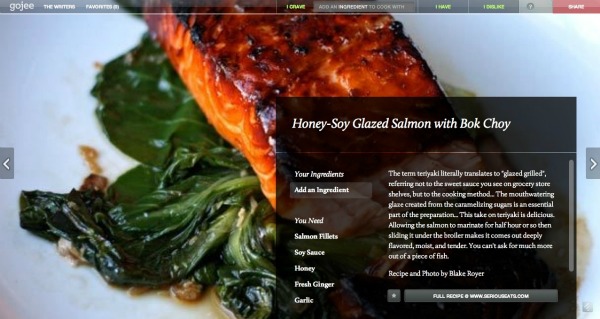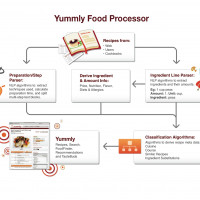One of the great challenges of building a startup is ensuring that your product meets market demand. This seems to be particularly true for data-driven startups, whose initial products often lack appeal for the average consumer. No matter how advanced, complex or innovative the technology is that powers a product, more often than not, user adoption is contingent on the simplicity of its design and user experience. The newly launched Gojee, a recipe site which allows users to search through hand-curated food blogger recipes based on what’s in your ‘pantry’, is case in point.
I first met co-founders Michael Lavalle and Tian He when they were getting ready to launch the ultra nerdy first version of Gojee, a Mint.com of food. The site enabled D’Agostino customers to access analytics on the nutritional value of food purchases and how their purchases compared to other shoppers, using their loyalty card data. As a data nerd, I loved version one, but apparently the market did not.
Two iterations later, the Gojee team seems to have hit a home run with their sleek and beautifully designed new site, which launched last week and has already been featured on Swiss Miss, TechCrunch, Gizmodo, Marcus Samuelsson’s blog, as well as others. I got a chance to speak with Michael about the new Gojee, what differentiates Gojee from other recipe sites, and the lessons he’s learned along the way.
Danielle Gould: What is the inspiration behind Gojee?
Mike Lavalle: Tian and I were working at Morgan Stanley and eating fried chicken from “Piece of Chicken” in Hell’s Kitchen for what we thought was the 3rd time in two weeks. But we couldn’t remember exactly how many times we’d had it (that’s a problem isn’t it?). Really got us thinking about how we could improve the relationship between what/where we eat and the technology supporting that experience.
DG: How does the site work?
ML: It’s really quite simple. You tell us what you’re craving and we give you hand-picked recipes from amazing food bloggers.
DG: Is Gojee just food porn? What differentiates you from other recipe sites? (could you describe any interesting algorithms you’ve developed)
ML: No:-) But that’s a part we’re proud of.
You could call us a high quality, hand curated, easy to use Google for food blogger recipes. Every recipe on our site is manually chosen by our team. Nothing is scraped. We also keep track of what you have at home by linking to your supermarket loyalty card or from what you’ve inputted into your “pantry” on Gojee.
Our best algorithm is Veronica Chan.
DG: Your site has gone through three drastically different iterations. Could you describe those and what about market demand influenced each version?
ML: Ahh this is painful. Our first site was a geeked out Mint for food. A little too geeked out. Lots of charts and graphs. I think we were a little early in the space, and we didn’t build a good enough product for people to love it. Our second was Twitter for Food + Epicurious + Groupon with a red bow on it. Ugh. No need to explain why that wasn’t a resounding success. The lack of market demand for both was pretty much the deciding factor. Our last version was just Tian and I late at 3am practically crying that everything in the food world we were building sucked. So we asked ourselves what could we do well that would be fun and wouldn’t make us cry anymore. And we came up with this. And this version makes us happy.
DG: Most people would not think of Gojee as a data-driven startup. What role does data play in your site? Where do you get your data from?
ML: One of the mind-blowing parts of Gojee is that we can link to your supermarket reward card (currently D’Agostino in NYC) and give you recipes based on the things you buy the most. We also require log-in so that we can learn your preferences and hopefully deliver more relevant results to your searches.
DG: What is your business model and how you obtain your data?
ML: Right now our business model is to deliver an experience everyone will love. The food space is huge and our partnerships with food writers, food retailers and grocery stores create a lot of opportunity for cross-collaboration.
DG: What value does D’Agostino derive from partnering with you? Was it difficult to secure the partnership?
ML: D’Agostino shoppers are the only ones in the world right now that can automate their pantry on Gojee. We’ll have others soon, but it’s pretty cool that a New York City grocery store (I’m a born and raised New Yorker!) took the lead in giving customers an experience they should have had ten years ago. I really have to give Nick D’Agostino Jr. and Nick D’Agostino III credit on this. They basically saw the future of foodtech and wanted it now for their customers.
DG: How do bloggers benefit from working with you?
ML: One of the things people love about Gojee is that they’re finding and discovering amazing food blogs and bloggers that they’ve never heard of. It’s a very personal experience. There are people behind all of these blogs and they’re as interesting as the recipes themselves.
DG: What are some of the greatest challenges you’ve faced?
ML: I think the hardest thing we had to learn was to build something that you want to use and that gets you excited. It sounds cliche, but it wasn’t until we built something for ourselves that it didn’t seem like work anymore and just turned into fun.
DG: What are the most interesting/unexpected things you’ve learned?
ML: Learning the importance of using a meat thermometer is one lesson that’s probably going to pay off for the rest of my life. Thanks @dhf2001. I’ve also really enjoyed meeting and talking with the people behind the recipes. We were lucky to have Kimberly Hasselbrink from swing by the office on her recent trip to NYC, and Meredith Steele from has a brother in Afghanistan (where I spent a year a prior life) so I’m really rooting for him to do well over there.
DG: What do think are the greatest opportunities that information technology creates for food?
ML: The next ten years are going to dramatically alter how we as Americans interact with food. This revolution will be very much like the disruption that happened to the Travel and Book/Retail industries from 1999-2010. Buckle up.






